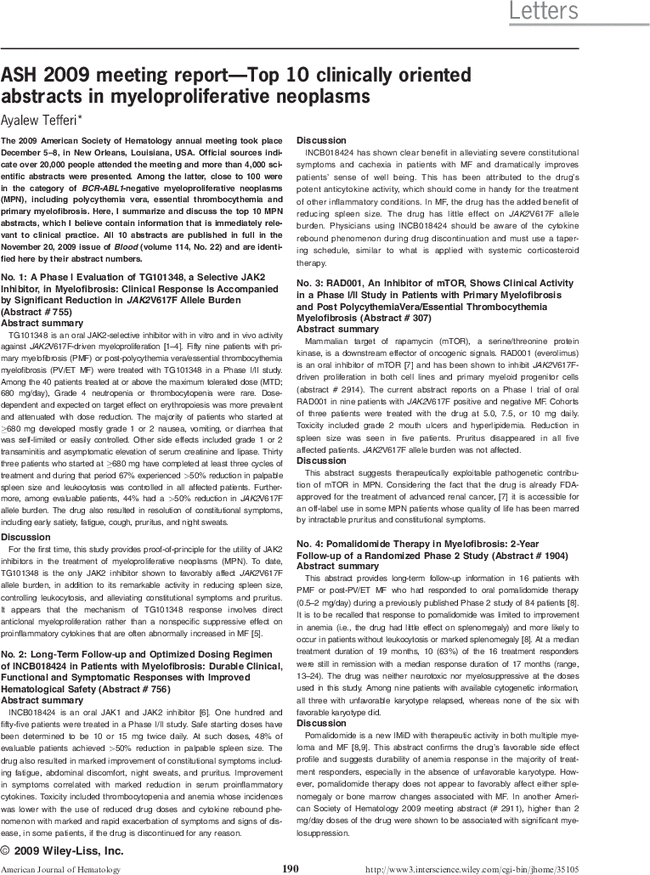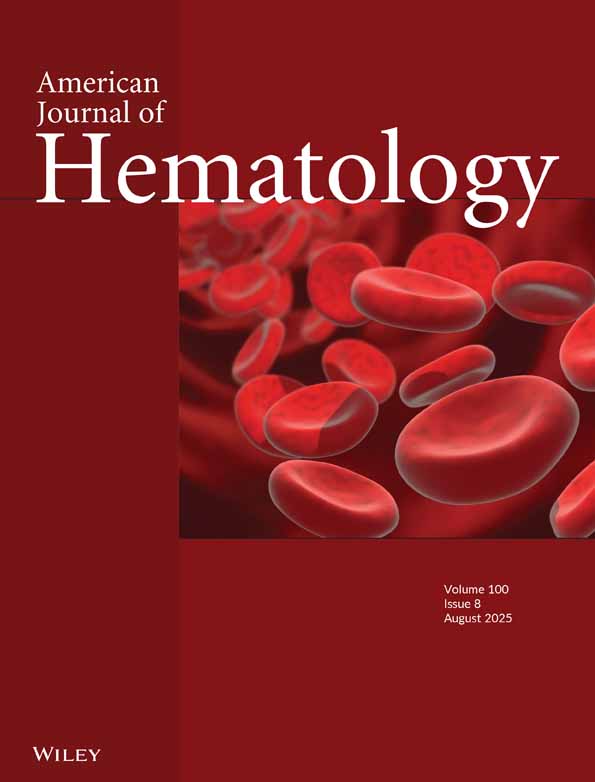Letter
Free Access
ASH 2009 meeting report—Top 10 clinically oriented abstracts in myelodysplastic syndromes†
David P. Steensma,
Corresponding Author
David P. Steensma
Division of Hematological Malignancies, Dana-Farber Cancer Institute, Harvard Medical School, Boston, Massachusetts
Division of Hematological Malignancies, Dana-Farber Cancer Institute, Harvard Medical School, 44 Binney Street, Suite D1B30 (Mayer 1B21), Boston, MA 02115Search for more papers by this authorDavid P. Steensma,
Corresponding Author
David P. Steensma
Division of Hematological Malignancies, Dana-Farber Cancer Institute, Harvard Medical School, Boston, Massachusetts
Division of Hematological Malignancies, Dana-Farber Cancer Institute, Harvard Medical School, 44 Binney Street, Suite D1B30 (Mayer 1B21), Boston, MA 02115Search for more papers by this authorFirst published: 31 December 2009
†
Conflict of interest: Nothing to report.

References
- 1 Olney HJ,Le Beau MM. The cytogenetics of myelodysplastic syndromes. Best Pract Res Clin Haematol 2001; 14: 479–495.
- 2 Haase D,Germing U,Schanz J, et al. New insights into the prognostic impact of the karyotype in MDS and correlation with subtypes: Evidence from a core dataset of 2,124 patients. Blood 2007; 110: 4385–4395.
- 3 Haase D. Cytogenetic features in myelodysplastic syndromes. Ann Hematol 2008; 87: 515–526.
- 4 Greenberg P,Cox C,LeBeau MM, et al. International scoring system for evaluating prognosis in myelodysplastic syndromes. Blood 1997; 89: 2079–2088.
- 5 Haase D,Estey EH,Steidl C, et al. Multivariate evaluation of the prognostic and therapeutic relevance of cytogenetics in a merged European-American cohort of 3,860 patients with MDS. Blood 2007; 110; Abstract #247.
- 6 SH Swerdlow, E Campo, NL Harris, et al, editors. WHO Classification of Tumours of Haematopoietic and Lymphoid Tissues, 4th ed. Lyon: IARC Press; 2008.
- 7
Steensma DP.
The changing classification of myelodysplastic syndromes: What's in a name?
Hematology
2009;
2009:
645–655.
10.1182/asheducation-2009.1.645 Google Scholar
- 8 Vardiman JW,Thiele J,Arber DA, et al. The 2008 revision of the World Health Organization (WHO) classification of myeloid neoplasms and acute leukemia: Rationale and important changes. Blood 2009; 114: 937–951.
- 9 Steensma DP,Dewald GW,Hodnefield JM, et al. Clonal cytogenetic abnormalities in bone marrow specimens without clear morphologic evidence of dysplasia: A form fruste of myelodysplasia? Leuk Res 2003; 27: 235–242.
- 10 Loss of the Y chromosome from normal and neoplastic bone marrows. United Kingdom cancer cytogenetics group (UKCCG). Genes Chromosomes Cancer 1992; 5: 83–88.
- 11 Steensma DP,Baer MR,Slack JL, et al. Multicenter study of decitabine administered daily for 5 days every 4 weeks to adults with myelodysplastic syndromes: The alternative dosing for outpatient treatment (ADOPT) trial. J Clin Oncol 2009; 27: 3842–3848.
- 12 Giagounidis AA,Germing U,Wainscoat JS, et al. The 5q- syndrome. Hematology 2004; 9: 271–277.
- 13 Tasaka T,Tohyama K,Kishimoto M, et al. Myelodysplastic syndrome with chromosome 5 abnormalities: A nationwide survey in Japan. Leukemia 2008; 22: 1874–1881.
- 14 Holtan SG,Santana-Davila R,Dewald GW, et al. Myelodysplastic syndromes associated with interstitial deletion of chromosome 5q: Clinicopathologic correlations and new insights from the prelenalidomide era. Am J Hematol 2008; 83: 708–713.
- 15 List A,Dewald G,Bennett J, et al. Lenalidomide in the myelodysplastic syndrome with chromosome 5q deletion. N Engl J Med 2006; 355: 1456–1465.
- 16 Malcovati L,Germing U,Kuendgen A, et al. Time-dependent prognostic scoring system for predicting survival and leukemic evolution in myelodysplastic syndromes. J Clin Oncol 2007; 25: 3503–3510.
- 17 Della Porta MG,Malcovati L,Boveri E, et al. Clinical relevance of bone marrow fibrosis and CD34-positive cell clusters in primary myelodysplastic syndromes. J Clin Oncol 2009; 27: 754–762.
- 18 Kantarjian H,O'Brien S,Ravandi F, et al. Proposal for a new risk model in myelodysplastic syndrome that accounts for events not considered in the original international prognostic scoring system. Cancer 2008; 113: 1351–1361.
- 19 Fenaux P,Mufti GJ,Hellstrom-Lindberg E, et al. Efficacy of azacitidine compared with that of conventional care regimens in the treatment of higher-risk myelodysplastic syndromes: A randomised, open-label, phase III study. Lancet Oncol 2009; 10: 223–232.
- 20 Silverman LR,Demakos EP,Peterson BL, et al. Randomized controlled trial of azacitidine in patients with the myelodysplastic syndrome: A study of the cancer and leukemia group B. J Clin Oncol 2002; 20: 2429–2440.
- 21 Gore SD. Intravenous azacitidine for MDS. Clin Adv Hematol Oncol 2007; 5: 234.
- 22 Marcucci G,Silverman L,Eller M, et al. Bioavailability of azacitidine subcutaneous versus intravenous in patients with the myelodysplastic syndromes. J Clin Pharmacol 2005; 45: 597–602.
- 23 Martin MG,Walgren RA,Procknow E, et al. A phase II study of 5-day intravenous azacitidine in patients with myelodysplastic syndromes. Am J Hematol 2009; 84: 560–564.
- 24 Lyons RM,Cosgriff TM,Modi SS, et al. Hematologic response to three alternative dosing schedules of azacitidine in patients with myelodysplastic syndromes. J Clin Oncol 2009; 27: 1850–1856.
- 25 Kantarjian H,Issa JP,Rosenfeld CS, et al. Decitabine improves patient outcomes in myelodysplastic syndromes: Results of a phase III randomized study. Cancer 2006; 106: 1794–1803.
- 26 Kantarjian H,Oki Y,Garcia-Manero G, et al. Results of a randomized study of 3 schedules of low-dose decitabine in higher-risk myelodysplastic syndrome and chronic myelomonocytic leukemia. Blood 2007; 109: 52–57.
- 27 List A,Kurtin S,Roe DJ, et al. Efficacy of lenalidomide in myelodysplastic syndromes. N Engl J Med 2005; 352: 549–557.
- 28 Raza A,Reeves JA,Feldman EJ, et al. Phase II study of lenalidomide in transfusion-dependent, low-risk, and intermediate-1 risk myelodysplastic syndromes with karyotypes other than deletion 5q. Blood 2008; 111: 86–93.
- 29 Sekeres MA,Maciejewski JP,Giagounidis AA, et al. Relationship of treatment-related cytopenias and response to lenalidomide in patients with lower-risk myelodysplastic syndromes. J Clin Oncol 2008; 26: 5943–5949.
- 30 Cazzola M. Myelodysplastic syndrome with isolated 5q deletion (5q- syndrome). A clonal stem cell disorder characterized by defective ribosome biogenesis. Haematologica 2008; 93: 967–972.
- 31 Jadersten M,Saft L,Pellagatti A, et al. Clonal heterogeneity in the 5q- syndrome: p53 expressing progenitors prevail during lenalidomide treatment and expand at disease progression. Haematologica 2009; 94: 1762–1766.
- 32 Mesa RA,Tefferi A,Li CY,Steensma DP. Hematologic and cytogenetic response to lenalidomide monotherapy in acute myeloid leukemia arising from JAK2(V617F) positive, del(5)(q13q33) myelodysplastic syndrome. Leukemia 2006; 20: 2063–2064.
- 33 Lancet JE,List AF,Moscinski LC. Treatment of deletion 5q acute myeloid leukemia with lenalidomide. Leukemia 2007; 21: 586–588.
- 34 Borthakur G,Garcia-Manero G,Faderl S, et al. Lenalidomide in high-risk myelodysplastic syndrome and acute myelogenous leukemia associated with chromosome 5 abnormalities. ASH Annu Meet Abstr 2007; 110: 1459.
- 35 Fehniger TA,Byrd JC,Marcucci G, et al. Single-agent lenalidomide induces complete remission of acute myeloid leukemia in patients with isolated trisomy 13. Blood 2009; 113: 1002–1005.
- 36 Ades L,Boehrer S,Prebet T, et al. Efficacy and safety of lenalidomide in intermediate-2 or high-risk myelodysplastic syndromes with 5q deletion: Results of a phase 2 study. Blood 2009; 113: 3947–3952.
- 37 Sloand EM,Rezvani K. The role of the immune system in myelodysplasia: Implications for therapy. Semin Hematol 2008; 45: 39–48.
- 38 Molldrem JJ,Leifer E,Bahceci E, et al. Antithymocyte globulin for treatment of the bone marrow failure associated with myelodysplastic syndromes. Ann Intern Med 2002; 137: 156–163.
- 39 Stadler M,Germing U,Kliche KO, et al. A prospective, randomised, phase II study of horse antithymocyte globulin vs rabbit antithymocyte globulin as immune-modulating therapy in patients with low-risk myelodysplastic syndromes. Leukemia 2004; 18: 460–465.
- 40 Steensma DP,Dispenzieri A,Moore SB, et al. Antithymocyte globulin has limited efficacy and substantial toxicity in unselected anemic patients with myelodysplastic syndrome. Blood 2003; 101: 2156–2158.
- 41 Saunthararajah Y,Nakamura R,Wesley R, et al. A simple method to predict response to immunosuppressive therapy in patients with myelodysplastic syndrome. Blood 2003; 102: 3025–3027.
- 42 Lim ZY,Killick S,Germing U, et al. Low IPSS score and bone marrow hypocellularity in MDS patients predict hematological responses to antithymocyte globulin. Leukemia 2007; 21: 1436–1441.
- 43 Ma X,Does M,Raza A,Mayne ST. Myelodysplastic syndromes: Incidence and survival in the United States. Cancer 2007; 109: 1536–1542.
- 44 Yue G,Hao S,Fadare O, et al. Hypocellularity in myelodysplastic syndrome is an independent factor which predicts a favorable outcome. Leuk Res 2008; 32: 553–558.




